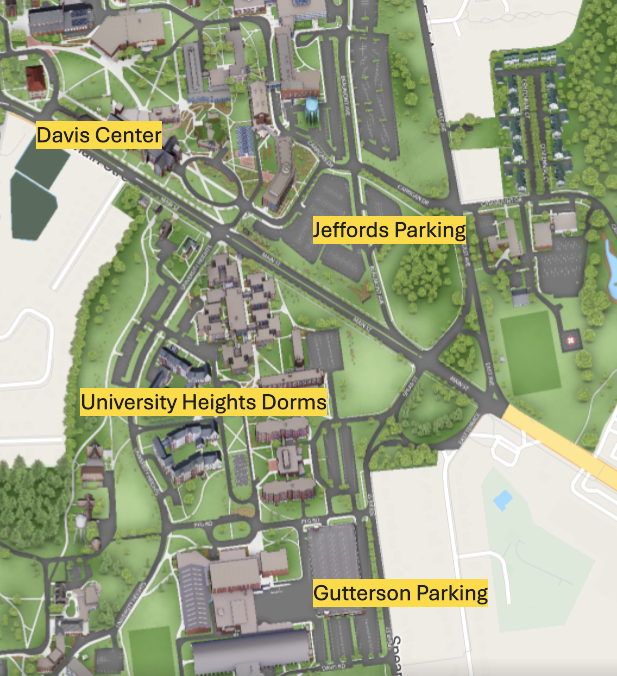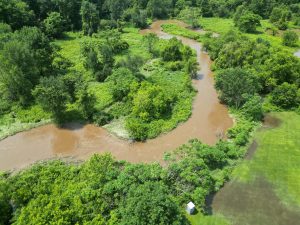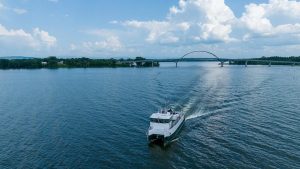
Introduction
CIROH is proud to host the 3rd annual Developers Conference at the University of Vermont in Burlington Vermont. The conference will be held from May 28th to May 30th, 2025. The training tracks for this year’s conference are Machine Learning, NextGen, Flood Inundation Mapping, Hydroinformatics, and Social Science.
Who should attend?
The conference will focus on a wide range of topics relating to hydrological forecasting, particularly of extreme events – in line with CIROH’s current research and development emphasis. These include hydrological modeling (NextGen), flood inundation mapping, hydroinformatics, social science, and community engagement. The conference will offer participants an opportunity to engage with the CIROH community and its federal partners, learn about recent research and development activities, and get hands-on training on emerging models, tools, and services.
Registration is now closed.
Agenda
Career-Building and Educational Field Activity
The University of Vermont will lead two pre-conference transdisciplinary career-building and educational field activities on May 27, 2025. The start times of the excursions differ to accommodate a range of arrival times. Signing up for the activities will be part of the conference registration.
Flood Impacts & Resilience
CIROH will host a field trip to a floodplain monitoring site along the conserved Lewis Creek to view impacts of the recent historic flooding, engage in field-based efforts to verify flood dynamics, and learn about on-going science, management, and policy work to improve resilience to climate change by restoring floodplain and wetland function. This activity will be outside and require appropriate clothing and footwear for hiking. There will be opportunities to walk alongside the river on a mowed path. Transportation will be provided from the UVM campus, departing at 2 pm. Participants should plan to arrive at the Davis Center no later than 1:45 pm. Here is the departure location. The buses are anticipated to arrive back to campus at 6 pm.
Water Quality and Lake Champlain
CIROH will host a field trip on Lake Champlain to learn about University of Vermont CIROH research to understand harmful algal blooms and socio-ecological systems of the coupled watershed-lake system and discuss Vermont’s on-going efforts to address water quality concerns. This field trip will be on UVM’s research and teaching vessel Marcelle Melosira and will expose participants to instrumentation used to monitor lake health. Participants should be prepared for variable conditions. Closed toe shoes are required, and life jackets will be provided. Two trips are planned to depart at 3:15 pm and 4:30 pm from the ECHO Leahy Center on the Burlington waterfront for one of two departure times. The boat rides will be approximately one hour.
Keynote Presentations
Day 1
Ed Clark
9:00 AM
Casting Forward: The future of water science and service amidst change
Gillian Galford
9:20 AM
Understanding weather and climate on scales that matter to communities
Andrew Schroth
9:40 AM
Sustained investments in monitoring and modeling research identify trends and drivers of water quality in the Lake Champlain Basin
Day 2
Cristina Urizar & Rebecca Atkins
8:40 AM
[Virtual] An introduction and update from NOAA’s National Ocean Service
Elliot Wickham
9:00 AM
NOAA’s National Integrated Drought Information System (NIDIS): What is it and how can it help connect you with drought needs across the United States?
Sean Fleming
9:20 AM
Navigating the Research-Applications Continuum: NASA’s Water Resources Program and Western Water Action Office
Brian Clark
9:40 AM
[Virtual] USGS Water Resources Mission Area – Modeling and Approach to Prediction
Savalan Neisary
10:00 AM
Advancing hydrological modeling: from post-processing with machine learning to community tools
Day 3
Reihaneh Zarrabi
8:35 AM
Bankfull and Mean-Flow Channel Geometry Estimation Through Machine Learning Algorithms Across the CONtiguous United States (CONUS)
Dan Ames, Arpita Patel
8:50 AM
CIROH Hydroinformatics/Research Cyberinfrastructure Tools & Technologies
Training Tracks
Machine Learning in Hydrology: The ML track will provide hands-on workshop sessions exemplifying ML methods using current CIROH modeling projects seeking to advance the application of ML in operational hydrology. CIROH will provide the CIROH Cloud workspace to ensure environmental stability; workshop leads will provide the material on GitHub and tentatively cover LSTM, XGBoost, and MLP modeling algorithms. Track attendees can expect to leave with greater knowledge of data processing, ML models and their respective applications, training and evaluation procedures, result visualization, and a stronger foundation to apply the workflows to their unique hydrological modeling objectives.
Lead: Ryan C. Johnson, University of Utah
Community NextGen: The “Community NextGen” track will focus on using the Next Generation Water Resources Modeling framework (NextGen) and will give participants hands-on experience with NextGen In A Box (NGIAB), a streamlined deployment solution for NextGen. Workshops will cover the use of tools to quickly prepare NextGen simulations, the TEEHR Evaluation Tool, and the Tethys Data Visualizer. The track will also explore advanced capabilities, including NextGen DataStream, providing insights into building and validating input packages for reproducible modeling workflows. Finally, the track will emphasize opportunities to contribute to the CIROH NextGen datastream, a baseline simulation of CONUS hydrology. Sessions will highlight best practices for community development and collaborative efforts within the NextGen platform.
Leads: Arpita Patel and James Halgren, University of Alabama
Flood Inundation Mapping: The track will provide well-rounded training on Flood Inundation Mapping (FIM), focusing on the operational OWP HAND-FIM framework as well as other FIM models and supporting tools. The workshop lineup and schedule are designed to follow the FIM application and development schema: compilation, evaluation, development, and application. Workshops will include an introduction session, software setup, OWP HAND-FIM and remote sensing application, evaluation against benchmark datasets, dissemination, and tool development.
Lead: Sagy Cohen, University of Alabama
Social Science and Communication: The track will focus on 1) sharing the importance and contribution of social science research to flood forecasting and information sharing and 2) enhancing researchers’ ability to effectively communicate and translate their findings to diverse audiences. Participants will explore strategies to align research with audience needs from the outset, ensuring maximum impact and accessibility. Workshops will cover critical skills such as applying cognitive principles to improve how information is interpreted, bridging the gap between complex research findings and public understanding, and tailoring scientific messaging to underserved and vulnerable communities. Attendees will gain practical experience in audience tailoring, inclusive communication strategies, and techniques for simplifying scientific narratives without compromising accuracy. This track is ideal for those looking to expand their reach, foster trust, and create meaningful connections between research and the communities it serves.
Lead: Jill Brown, RTI International
Hydroinformatics and Data Science: The track will include workshops that will train participants on the expanding spectrum of water data science tools and technologies being developed and offered to enhance the research-to-operations initiatives of NOAA and CIROH. Collectively presented under the theme of “hydroinformatics,” the workshops will cover hydrologic data science, collaboration and data sharing through HydroShare, cloud computing using CIROH Cloud resources, geographic information systems (GIS) and remote sensing applications, web applications for National Water Model data visualization and decision support using Tethys Platform and other web technologies, application programming interfaces (APIs) through Google Cloud BigQuery and Amazon Web Services, containerized NextGen Framework through NextGen In A Box (NGIAB), among other related topics.
Lead: Dan Ames, Brigham Young University
Poster and Lightning Talk Presentations
Important Dates
February 10: Registration, abstract submission and workshop signup opens
February 21: Nomination deadline for the Student Developer Award and Early Career Paper Award
March 15: Notifications about the Awards
April 11 – May 6: Hotels’ block reservation closes (see Housing)
May 27: Pre-conference networking activities
May 28 – 30: CIROH Developers Conference
Registration
A link to the Registration Form will be available on February 10th. Once you have completed the form and your registration is confirmed, you will be contacted via email with instructions regarding registration payment ($100 for students, $200 for non-students). Upon receipt of payment, you will be sent an email containing instructions on signing up for Training Workshops. These workshops fill up quickly, so try to register early.
Early Career Awards
Student Developer Award
Applications close February 21, 2025
The CIROH Annual Student Developer Award will honor a student who has demonstrated an outstanding contribution to CIROH’s research endeavors. The top submission will be invited to provide a keynote presentation at the conference and will receive travel support. Submission is restricted to students from the CIROH Consortium Member and Partner institutions.
To apply, send the following material to bssa-ciroh@ua.edu by February 21, 2025:
- A short description of your contribution to CIROH research [1 page];
- [Optional] A digital copy of one of your relevant thesis/dissertation chapter, research paper, or supporting documents [please do not submit your entire thesis!];
- [If relevant] A link to a public repository of your code or dataset with an open-source license, and technical documentation (optional);
- A letter of endorsement from the advisor – Please instruct them to email it directly to bssa-ciroh@ua.edu. It must be received no later than February 21, 2025.
Early Career Paper Award
Applications close February 21, 2025
The CIROH inaugural Early Career Paper Award will honor a student or postdoc who has published a seminal paper associated with a CIROH research project. The top submission will be invited to provide a keynote presentation at the conference and will receive travel support. Submission is restricted to students and postdocs from the CIROH Consortium Member and Partner institutions. The paper must be published (i.e. not under review) in a peer-reviewed journal and include an acknowledgment of the CIROH project.
To apply, send the following material to bssa-ciroh@ua.edu by February 21, 2025:
- A short description of your paper and its contribution to CIROH research [1 page];
- A digital copy (PDF) of the research paper.
- [If relevant] A link to a public repository of your code or dataset with an open-source license, and technical documentation (optional).
Venue
The CIROH Training and Developer’s Conference will be held at the University of Vermont’s Dudley H. Davis Center.
Both the Hilton and Marriot have rooms blocked out for attendees. See below to reserve a room.
Driving Directions and Address
Address
UVM Dudley H. Davis Center – Level 4
590 Main Street
Burlington, VT 05405
From the airport
As you leave the airport, head north on Airport Circle. Turn right on Airport Drive for 335 feet, then turn left onto White Street. Continue for 0.8 mile, then turn right onto US-2 W / Williston Rd. Continue for 0.9 mile. Bear right onto East Avenue and after 0.2 mile, turn left onto Carrigan Drive. Parking is available on your left in the Jeffords Parking Lot. Then head towards Main Street, where you will see the Davis Center to your west.
From the Waterfront
Head up Main Street to connect to East Ave. Take a left onto East Ave and after 0.2 mile, turn left onto Carrigan Drive. Parking is available on your left in the Jeffords Parking Lot. Walk towards Main Street. You will see the Davis Center to your west.
Parking
There is parking available at the Jeffords Parking lot. If you follow the above driving directions, you will end up in this large parking lot (the Jeffords lot). You can purchase parking via the ParkMobile app. During the event, the ParkMobile Zones will be extended so attendees can park anywhere in the lots listed below rather than in the marked spaces.
For Jeffords Lot: Zone 6002
For Jeffords East Lower Lot or JELL: Zone 6115
For Gutterson Lot: 6001
For more directions and parking information: Directions and Parking | The Dudley H. Davis Center | The University of Vermont

Public Transportation
If you plan to use public transportation, you may want to consider booking a hotel in proximity to the College Street Shuttle, which runs from Burlington’s waterfront to UVM at 15-minute intervals.
- Green Mountain Transit: GMT is the public bus service for North-Western Vermont. It is headquartered in Chittenden County and serves the surrounding counties.
- Trip Planner: www.ridegmt.com/trip-planner/
- GMT bus line 11 travels from the BTV Airport to Beaumont Street at Carrigan Drive – a close walk to University Heights and the Davis Center
- College Street Shuttle runs from Burlington’s waterfront to UVM at 15-minute intervals.
- Trip Planner: www.ridegmt.com/trip-planner/
- On-Campus Bus Shuttle: Bus UVM SHUTTLE | Transportation and Parking Services | The University of Vermont
- Track the buses in real time: Rider Portal – the Davis Center and University Heights are located on the “On Campus” bus line.
Campus Map
For more detailed information about University of Vermont campus, look at this campus map.
Organizing Committee
Sagy Cohen – University of Alabama
Dan Ames – Brigham Young University
Jill Brown – RTI International
Ryan Johnson – University of Utah
Arpita Patel – University of Alabama
James Halgren – University of Alabama
Rebecca Diehl – University of Vermont
Beverley Wemple – University of Vermont
Hannah Fischer – University of Vermont
Lanna Nations – University of Alabama
Gabbrielle Steele – University of Alabama


